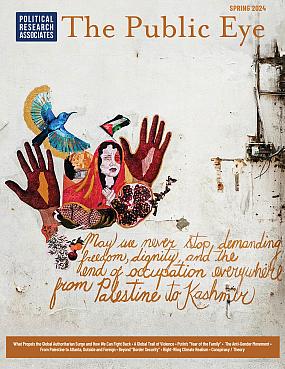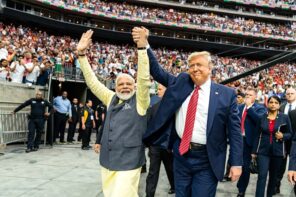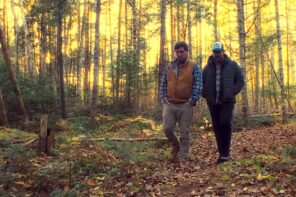On December 31, 2023, President Vladimir Putin wished Russia a “Happy New Year” from the safety of the Kremlin, the traditional site of the presidential New Year’s Eve address since the 2000s.[1] The familiar picture presented a stark contrast to the military spectacle of the previous year’s address.

The Public Eye, Spring 2024 (Issue 109) examines the far-right expansion of authoritarianism globally.
Inform your resistance: Subscribe now!
At the end of 2022, Putin shocked the country and the world by addressing the nation from a military base in Rostov-on-Don—a southwestern city by the Russia-Ukraine border—against the backdrop of stern-looking soldiers.[2] This year’s change in venue, however, wasn’t the only thing that signaled Russia’s return to the safety of tradition. In a scaled-back speech that lasted only 3 minutes and 44 seconds—his shortest New Year’s Eve address in recent years—Putin declared 2024 the Year of the Family in Russia. He mentioned Russia’s war on Ukraine only in passing. While many publications, including the BBC, Daily Mail, and The New York Times[3] noted the conspicuous absence of more explicit references to the ongoing bloody conflict, none commented on the main subject of Putin’s address: the advancement of traditional family values.
At first glance, the phrase “traditional family values”[4] might appear absurd when applied to a large, multiethnic country—one that toyed with rather radical ideas about free love, abortion, and the dissolution of marriage about a century ago.[5] But when positioned against the past century’s social and political changes, Putin’s marriage of “tradition” and “family” acquires a new meaning.
According to Russian sociologists, the “demographic crisis” that has haunted Russia since its colossal losses in World War II[6] reached the level of a “demographic Chernobyl” after the Soviet Union’s collapse.[7] From 1993 to 2023, Russia’s population has, in fact, declined by over 4,000,000 people.[8] Exacerbated by emigration trends, war efforts, and declining birth rates, Russia’s current population decline indicates, from the Kremlin’s standpoint, a crisis of the nation and threatens Russia’s position as a global superpower.[9] In this context, Putin’s rallying cry of traditional family values is not surprising at all. In fact, it’s so familiar and self-explanatory to most Russian audiences that it doesn’t have to be stated explicitly. But make no mistake. Although the word “tradition” was absent from Putin’s 2023 New Year’s Eve address, advancing traditional family values lies at the core of his current political agenda.
Using a strategically vague and slippery framing of “tradition” allows Putin’s administration to appeal to domestic and transnational conservative movements alike. During the All-Russian Family Forum’s Year of the Family launch in January 2024, for example, Putin defined “traditional family values” as “strong and reliable ties between generations, respect for parents, care for elders, and our grandparents’ love” and the continuation of “simply normal human values.”[10] In his New Year’s Eve speech a few weeks earlier, Putin spoke of “a true big family,” “faith of our fathers,” and “one big family” as a metaphor for “the Motherland” and its “national interests…freedom and security.”[11] Analyzing these rhetorical shifts in context reveals that Putin’s “traditional family values,” at its core, refers to an ethnically pure, heteronormative family structure defined by a strict division of labor, an alignment with Christian views on marriage, and a focus on childbearing. As such, it “does not simply refresh [Russian] pre-revolutionary values,”[12] but rather strategically blends the state’s ideological discourse with contemporary teachings of the Russian Orthodox Church and the far-right rhetoric of the global pro-family movement,[13] while evoking and reversing an American Cold War rhetoric of containment culture.
Originally used to describe U.S. foreign policy in the 1940s through the 1980s, containment became a powerful metaphor for cultural narratives that, as Alan Nadel writes, “equated containment of communism with containment of atomic secrets, of sexual license, of gender rules, of nuclear energy, and of artistic expression.”[14] As such, the image of an Anglo-Saxon, God-fearing, nuclear family happily raising their children in the suburbs and adhering to traditional gender roles also became a symbol of American exceptionalism, a standard to which other nations should aspire, and a weapon in the U.S.-Soviet competition for global influence. Today, the same weaponization of family values that was once used by the United States to sustain Christian anti-Communist attitudes underlies Putin’s war on the “woke” West.[15]
The question is not how this happened. We know how. After the collapse of the Soviet Union, U.S. evangelicals flooded Russia just as the country was rebuilding its economy and culture and as the ties between Russian political and religious institutions were, once again, growing stronger. This ideological exchange marked a new stage in Orthodox Christianity characterized by close ties between U.S. evangelicals and Russian conservatives.[16] The question we should ask instead is what Putin’s celebration of family values tells us about where Russian national and international politics are heading.
Encompassing a wide range of global trends, from anti-LGBT legislation to a growing anti-abortion agenda to the rise of ethnic nationalism, Putin’s “war on woke” positions the liberal democratic West as the major threat to Russia’s traditional family order.[17] This ideological agenda advances the myth of Russian civilizational exceptionalism by positioning ethno-cultural Russians as God’s chosen people destined to revive traditional family values and save the world from the cultural and spiritual decline ushered in by liberal multicultural elites.[18] This growing emphasis on the centrality of Russian culture, language, and a nationalist version of history, is what Helge Blakkisrud terms Putin’s redefinition of national identity “from a predominantly civic understanding based on citizenship and identification with the state, to a more ethnic one focused on Russian language and culture, one in which the ethnic Russians take centre stage.”[19] Used to justify Russia’s invasion of Ukraine, this reframing of Russian identity and mission also finds sympathetic ears in the West.[20] Putin’s disdain for liberal democracies, coupled with his emphasis on traditional family values and restoring Russia’s “historical unity,” resonates with the U.S. Far Right’s mission to bring about a White ethnostate. [21]
Putin’s revival and reversal of right-wing U.S. Cold War rhetoric demonstrates that he is aware of the double advantage that evoking familiar yet broad concepts—such as “tradition,” “Russian,” and “the West”—can grant in today’s political context, 30 years after the end of Soviet Communism and amid growing authoritarianism worldwide. References to the West are kept purposefully vague so that the Kremlin’s “pro-family” battle aligns with U.S. conservatives and White nationalists’ own culture war against “woke elites,”[22] rather than treating them as anti-Russian threats to be countered. For instance, at the 2024 Year of the Family launch, Putin positioned Russia in opposition to other countries that he claimed were destroying family values without making any specific references: “As you know, today some countries are cynically destroying the institution of the family and common, simply normal human values are cynically broken down and replaced by false ones. Traditional family values drop out of favour in these countries. But we, on the contrary, will preserve, strengthen, and pass them on to future generations.”[23] Putin’s rhetoric paints the dangerous West in deliberately broad strokes to elicit strong emotional response from his Russian supporters and attract support from those religious and political agents in the West who share his far-right views.[24]
In this way, Putin’s positioning of the traditional family as the basis of Russia’s national security and economic development taps into a White supremacist rhetoric of family values and demographic decline that has come to define the Global Right’s war on reproductive rights.[25] The parallels are not coincidental. Since the establishment of the World Congress of Families (WCF) in 1997,[26] the U.S. Christian Right has worked closely with Russian Orthodox leaders, politicians, and conservative oligarchs to export the idea of “the natural family”—a White, Christian, heteronormative two-parent household with children—across Eastern Europe and the West through a series of international and regional conferences.[27] Russia’s pronatalist policies of the last two decades are a testament to the success of this cooperation.[28]
Since the first Year of the Family in 2008,[29] the Kremlin’s focus has shifted from raising the overall quality of family life through social projects in health care, education, and housing to encouraging women to bear more children by offering monetary incentives in the form of maternity capital and by restricting access to reproductive services.[30] Russian “crisis pregnancy centers” with biased counseling, mandatory waiting periods, and restrictions on late-term abortions bear, as Carol Mason notes, the unmistakable signs of “US antiabortion tactics and rhetoric” in an attempt “to thwart abortion as a supposed cause of demographic demise.”[31] Russia’s “traditional family values” rhetoric is further aided by an ideological and institutional alliance between the Kremlin and the Russian Orthodox Church. Although abortion is still legal in Russia, Putin’s New Year’s Eve speech—which came mere days after the Holy Synod called upon Russian law to protect life from the moment of conception, citing the legislation of “многих стран” (“many countries”) in another purposefully vague reference[32]—indicates that this might not be the case for long. With Putin emphasizing how “important [it is] for us to have more large families,”[33] the Kremlin will likely continue to try to use incentivized or forced population growth to resolve Russia’s demographic and international concerns.
In light of his recent victory in Russia’s March 2024 presidential elections, Putin’s New Year’s Eve declaration speaks volumes about his ongoing national and international political agenda. With the Russian Orthodox Church advocating for a complete abortion ban and some regional attempts to ban abortions in local private clinics,[34] Putin’s statement that “a true big family is of course a family with children” indicates that the state’s attack on reproductive rights, including access to abortion, birth control, and family planning services, is likely to intensify in the coming year.[35] Of course, the speech contains some obligatory nods towards the country’s ethnic diversity: “We, the multinational people of Russia, shape its future.”[36]
But with Russia’s war on Ukraine entering its third year, troubling trends in the 2021 Russian census,[37] and the ongoing “Russification” of the nation’s civic identity since the Second Chechen War,[38] the President’s words about the equality of all Russian citizens, irrespective of their ethnicities and nationalities, ring hollow. Rather, Putin’s current emphasis on Russian historical unity and adhering to traditional values suggests that the Kremlin’s long-term project is that of cultural imperialism: “We are one country, one big family.”[39] With the ethnic Russian population declining faster than that of Russian minorities,[40] “one family” evokes the image of an ethnically pure Russian traditional family with “with three or more children.”[41]
As Russia’s geopolitical borders and national identity continue to shift, Putin’s choice to center traditional family values in his 2024 campaign is telling and alarming. In the Kremlin’s rhetoric, the “traditional” family—that is, a heteronormative, Christian, Russian family with three or more children—is a defining feature of Russian exceptionalism that also becomes the solution to Russia’s demographic decline. While vague and slippery at first, Putin’s revival and reversal of right-wing U.S. Cold War rhetoric, in fact, relies on a purposefully ambiguous articulation of “tradition,” “the West,” and “Russian.” This calculated blurring of terms allows Putin to rally support for his regime from within Russia while attracting the backing of various conservative agents around the world—most visibly, the U.S. Christian Right, White nationalists, and the global “pro-family” movement.
Endnotes
[1] Yulia Afanasyenko, “Russian Tradition: The History and Secrets of the President’s New Year’s Address,” Russia Beyond, December 30, 2020.
[2] Anton Troianovski and Anatoly Kurmanaev, “Putin Prepares Russians for a Long Fight Ahead,” The New York Times, January 3, 2023.
[3] Miriam Kuepper and Perkin Amalaraj, “Putin warns Russia ‘will never back down,’” Daily Mail, December 31, 2023; Constant Méheut and Anton Troianovski, “As Missiles Fall and New Year Dawns, Putin and Zelensky Address Citizens,” The New York Times, December 31, 2023; “Vladimir Putin Makes Little Mention of Ukraine in New Year Speech,” BBC, December 31, 2023.
[4] The exact phrasing—“traditional family values”—comes from Putin’s speech at January’s launch of the Year of the Family in Russia rather than his New Year’s Eve speech. However, as this article argues, the phrases “traditional values” and “traditional family values” are purposefully kept interchangeable in Russian contemporary political context.
[5] “The Soviet Family,” The Atlantic, February 1, 1952.
[6] David M. Adamson and Julie DaVanzo, “Russia’s Demographic ‘Crisis’: How Real Is It?” RAND Corporation, January 1, 1997.
[7] Michele Rivkin-Fish, “Anthropology, Demography, and the Search for a Critical Analysis of Fertility: Insights from Russia,” American Anthropologist 105, no. 2 (2003): 289–301.
[8] Russia’s population peaked in 1993 at 148.6 million. By 2023, it was estimated at 144.4 million. See “Russia Population 1950-2024,” Macrotrends.
[9] Bloomberg, “Russia’s Population Is in Historic Decline from Emigration, War and Plunging Birth Rate,” Fortune, October 18, 2022.
[10] Team of the Official Website of the President of Russia, “Launching the Year of the Family in Russia,” President of Russia, January 27, 2024,
[11] Team of the Official Website of the President of Russia, “New Year Address to the Nation,” President of Russia, December 31, 2023.
[12] Katharina Bluhm and Martin Brand, “‘Traditional Values’ Unleashed: The Ultraconservative Influence on Russian Family Policy,” New Conservatives in Russia and East Central Europe, edited by K. Bluhm and M. Varga (London, New York: Routledge, 2018): 224.
[13] The global pro-family movement refers to a network of anti-abortion and anti-gay activists and right-wing groups that, under the tutelage of the World Congress of Families (discussed below), wage a spiritual war in the name of “what they call ‘the natural family,’ that is, a nuclear family consisting of a married man and woman and their children.” For the quote and more information on the role that WCF plays in the global pro-family movement, see Chrissy Stroop, “A Right-Wing International?” The Public Eye, February 16, 2016.
[14] Alan Nadel, Containment Culture: American Narrative, Postmodernism, and the Atomic Age (Durham, NC: Duke University Press, 1995), 5.
[15] Mikhail Zygar, “Russia’s War on Woke,” Foreign Affairs, January 2, 2024.
[16] Katherine Kelaidis, “A Twisted Love Story: How American Evangelicals Helped Make Putin’s Russia and How Russia Became the Darling of the American Right,” Religion Dispatches, March 2, 2022.
[17] Zygar, “Russia’s War on Woke;” Helge Blakkisrud, “Blurring the Boundary between Civic and Ethnic: The Kremlin’s New Approach to National Identity under Putin’s Third Term,” in The New Russian Nationalism, ed. Helge Blakkisrud and Pål Kolstø (Edinburgh University Press, 2016): 249–74.
[18] Putin, according to European media, has consistently blamed “the rise of gender diversity and multiculturalism” in the U.S. for weakening Russia’s traditional family values and, therefore, the country’s unity and health. See Wesley Rahn, “Putin: Liberal Idea Has ‘Outlived Its Purpose,’” Deutsche Welle (DW), June 28, 2019.
[19] Blakkisrud, “Blurring the Boundary,” 250.
[20] When annexing the Donetsk People’s Republic and Luhansk People’s Republic from Ukraine, for example, Putin cited “restoring our historical unity” as one of Russia’s justifications for invading Ukraine. In that speech, like many others, he placed emphasis on Russia and Ukraine’s shared history, Orthodox faith, and linguistic and cultural similarities. See Team of the Official Website of the President of Russia, “Signing of Treaties on Accession of Donetsk and Lugansk People’s Republics and Zaporozhye and Kherson Regions to Russia,” President of Russia, October 1, 2022.
[21] White nationalists’ reverence of Putin and his vision on Russia is well documented. See, for example, Kelaidis, “A Twisted Love Story;” Sergio Olmos, “‘Key to White Survival’: How Putin Has Morphed into a Far-Right Savior,” The Guardian, March 5, 2022. For the quote, see Olmos, “‘Key to White Survival.’”
[22] David Brooks, “The Terrifying Future of the American Right,” The Atlantic, November 18, 2021.
[23] Team, “Launching the Year of the Family in Russia.”
[24] Serhiy Hovorun, “‘Traditional Values’ Are Russia’s Geopolitical Weapons,” Public Discourse, July 26, 2023.
[25] Alex DiBranco, “The Long History of the Anti-Abortion Movement’s Links to White Supremacists,” The Nation, February 3, 2020; Siân Norris, Bodies Under Siege: How the Far-Right Attack on Reproductive Rights Went Global (London and Brooklyn: Verso, 2023).
[26] Southern Poverty Law Center, “World Congress of Families,” Accessed March 6, 2024; Political Research Associates, “Profiles on the Right: World Congress of Families,” November 4, 2013; Stroop, “A Right-Wing International?”
[27] Neil Datta, “Tip of the Iceberg: Religious Extremist Funders against Human Rights for Sexuality & Reproductive Health in Europe,” European Parliamentary Forum for Sexual and Reproductive Rights, June 2021.
[28] Pronatalism refers to domestic programs and policies meant to increase the country’s fertility rate and promote child-bearing and parenthood. For the overview of pronatalist policies in Russia, see Linda J. Cook, Elena R. Iarskaia-Smirnova, and Vladimir A. Kozlov, “Trying to Reverse Demographic Decline: Pro-Natalist and Family Policies in Russia, Poland and Hungary,” Social Policy and Society 22, no. 2 (April 2023): 355–75.
[29] Team of the Official Website of the President of Russia, “Speech at the Opening Ceremony for the Year of the Family in Russia,” President of Russia, January 25, 2008.
[30] Lyubov Vladimirovna Erofeeva, “Traditional Christian Values and Women’s Reproductive Rights in Modern Russia—Is a Consensus Ever Possible?” American Journal of Public Health 103, no. 11 (November 2013): 1931–34.
[31] Carol Mason, “Opposing Abortion to Protect Women: Transnational Strategy since the 1990s,” Signs 44, no. 3 (April 1, 2019): 675.
[32] For the full quote (in Russian), see Официальныйсайт Московского Патриархата, “О неприкосновенности жизни человека с момента зачатия,” December 27, 2023; For the Western coverage of the Holy Synod’s document (in English), see “Russian Synod Adopts Document, ‘On the Inviolability of Human Life from the Moment of Conception,’” Orthodox Christianity, December 28, 2023.
[33] Team, “Launching the Year of the Family in Russia.”
[34] Dasha Litvinova, “Abortion Restrictions in Russia Spark Outrage as the Country Takes a Conservative Turn,” AP News, October 27, 2023.
[35] Team, “New Year Address to the Nation.”
[36] For the quote, see Team, “New Year Address to the Nation.” According to the 2021 Russian census, there are 193 different ethnic groups residing on the territory of Russia, with nearly 72 percent of the population identifying as ethnic Russians.
[37] According to the 2021 census, Russian total population grew only by just over 1 percent from 2010 to 2021. The North Caucasus was the only region that experienced growth in absolute terms; the rest of the country experienced the demographic decline both in terms of absolute numbers and the percentage of ethnic minorities. Furthermore, the number of people who refused to declare their ethnicity rose to nearly 16.5 million—nearly 11 percent of the total Russian population in 2021—according to the official numbers. When read against the dwindling numbers of some of Russia’s largest ethnic minority groups, such as Tatars, Bashkirs, Chuvash, Avars, Armenians, and Ukrainians, this data suggests that many Russian citizens do not feel safe enough to disclose their ethnic identity in the current political climate defined by the Russification of the nation. See Robert Coalson, “Russia’s 2021 Census Results Raise Red Flags Among Experts And Ethnic-Minority Activists,” Radio Free Europe/Radio Liberty, February 5, 2023; Adam Lenton, “Russia’s Changing Ethnic Landscape: Three Takeaways from the 2021 Census,” Russia.Post, January 30, 2023.
[38] Blakkisrud, “Blurring the Boundary between Civic and Ethnic.”
[39] Team, “New Year Address to the Nation.” With Russia’s war on Ukraine entering its third year, Putin’s “one country” vision appears to be a nationalist-imperialist state grounded in Russian exceptionalist mythology and a Russia-centered interpretation of Soviet and Ancient Rus’ history.
[40] The 2021 census registered a population decline amongst most regions and ethnic groups, but ethnic Russians suffered the biggest blow in terms of absolute numbers: “The decline was largest among ethnic Russians, whose number, the census of 2021 said, fell by 5.4m in 2010-21. Their share of the population fell from 78% to 72%.” See “Russia’s Population Nightmare Is Going to Get Even Worse,” The Economist, April 10, 2023. In comparison, “Russia’s ethnic republics accounted for almost half of the 26 regions that grew between 2010 and 2021, despite comprising less than a quarter of Russia’s regions overall.” See Lenton, “Russia’s Changing Ethnic Landscape.”
[41] Team, “Launching the Year of the Family in Russia.”





